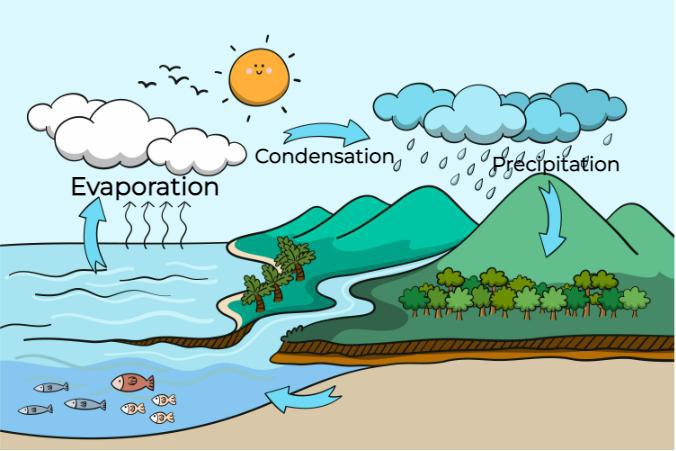Understanding Condensation: A Comprehensive Guide
Condensation is a fundamental process in the natural world, playing a crucial role in the water cycle, weather patterns, and various industrial applications. This article delves into the science behind condensation, its mechanisms, examples, and significance, while also addressing common questions in a comprehensive FAQ section.
What is Condensation?
Condensation is the process by which water vapor in the air is transformed into liquid water. This occurs when the vapor cools to its dew point, the temperature at which air becomes saturated with moisture. When this happens, the water molecules lose energy and come together to form liquid droplets.
The Science of Condensation
Basic Principles
The process of condensation can be understood through the following principles:
- Phase Change: Condensation is a phase change, where a substance transitions from a gaseous state to a liquid state. This is the opposite of evaporation, where liquid turns into vapor.
- Energy Transfer: During condensation, heat energy is released into the environment. This release of energy occurs because the molecules in the gas lose kinetic energy as they come together to form a liquid.
- Dew Point: The dew point is a critical concept in understanding condensation. It is the temperature at which air becomes saturated with moisture, leading to condensation. The higher the humidity, the higher the dew point.
- Condensation Nuclei: For condensation to occur, water vapor needs a surface or particles (known as condensation nuclei) to condense upon. These can be dust, pollen, or other small particles in the atmosphere.
The Process of Condensation
Steps Involved
- Cooling of Air: As warm air rises, it cools. When the temperature drops to the dew point, the air becomes saturated.
- Formation of Droplets: Water vapor condenses around condensation nuclei, forming tiny droplets of liquid water.
- Visibility: When enough droplets form, they become visible as fog, clouds, or dew.
Examples of Condensation
Condensation is observed in various everyday phenomena:
- Dew: In the early morning, dew forms on grass and leaves as the temperature drops overnight.
- Fog: Fog is a thick cloud of tiny water droplets suspended in the air, formed when warm, moist air cools rapidly.
- Clouds: Clouds are formed when water vapor in the atmosphere condenses into droplets around particles in the air.
- Condensation on Cold Surfaces: When a cold drink is taken out of the refrigerator, moisture from the warm air condenses on the cold surface of the glass.
The Role of Condensation in the Water Cycle
Condensation plays a vital role in the water cycle, which involves the continuous movement of water on, above, and below the Earth’s surface. The water cycle consists of several processes, including evaporation, condensation, precipitation, and runoff.
| Process | Description |
|---|---|
| Evaporation | Water from the Earth’s surface turns into vapor and enters the atmosphere. |
| Condensation | Water vapor cools and condenses into liquid droplets, forming clouds. |
| Precipitation | Water droplets combine and fall to the ground as rain, snow, sleet, or hail. |
| Runoff | Water flows over the surface and returns to oceans, rivers, and lakes. |
Applications of Condensation
Condensation is not only a natural phenomenon but also has practical applications in various fields:
- Meteorology: Understanding condensation is essential for predicting weather patterns and phenomena such as rain and storms.
- HVAC Systems: In heating, ventilation, and air conditioning (HVAC) systems, condensation is managed to maintain humidity levels and improve air quality.
- Industrial Processes: Condensation is used in distillation processes to separate components based on their boiling points.
- Power Generation: In steam turbines, condensation is crucial for converting steam back into water, which can then be reused in the system.
Factors Affecting Condensation
Several factors influence the rate and efficiency of condensation:
- Temperature: Lower temperatures increase the likelihood of condensation as the air cools to its dew point.
- Humidity: Higher humidity levels mean more water vapor is present, increasing the chances of condensation.
- Pressure: Changes in atmospheric pressure can affect the condensation process. For example, increasing pressure can lead to condensation at higher temperatures.
- Surface Area: The presence of more condensation nuclei or larger surfaces can enhance the condensation process.
Common Misconceptions About Condensation
- Condensation is the Same as Precipitation: While condensation is a part of the process that leads to precipitation, they are not the same. Precipitation refers to the falling of water droplets from clouds.
- Condensation Only Occurs Outdoors: Condensation can occur in any environment where warm, moist air comes into contact with cooler surfaces, including indoors.
- Condensation is Always Visible: While condensation often results in visible droplets, it can also occur in the air without forming clouds or dew.
FAQ Section
- What causes condensation?
- Condensation occurs when warm, moist air cools to its dew point, causing water vapor to change into liquid water.
- How does condensation differ from evaporation?
- Condensation is the process of gas turning into liquid, while evaporation is the process of liquid turning into gas.
- What is the dew point?
- The dew point is the temperature at which air becomes saturated with moisture, leading to condensation.
- Can condensation occur indoors?
- Yes, condensation can occur indoors when warm, moist air comes into contact with cooler surfaces, such as windows or walls.
- What are condensation nuclei?
- Condensation nuclei are small particles, such as dust or pollen, around which water vapor condenses to form droplets.
- How does condensation affect weather?
- Condensation is a key process in cloud formation and precipitation, influencing weather patterns.
- Is condensation a physical or chemical change?
- Condensation is a physical change, as it involves a change in the state of matter without altering the chemical composition.
- What are some everyday examples of condensation?
- Common examples include dew on grass, fog, and water droplets on a cold glass.
Conclusion
Condensation is a vital process that occurs in nature and has significant implications for weather, the water cycle, and various industrial applications. By understanding the principles of condensation, we can better appreciate its role in our environment and its practical uses in technology and industry.For more detailed information about condensation, you can refer to the following resource:



